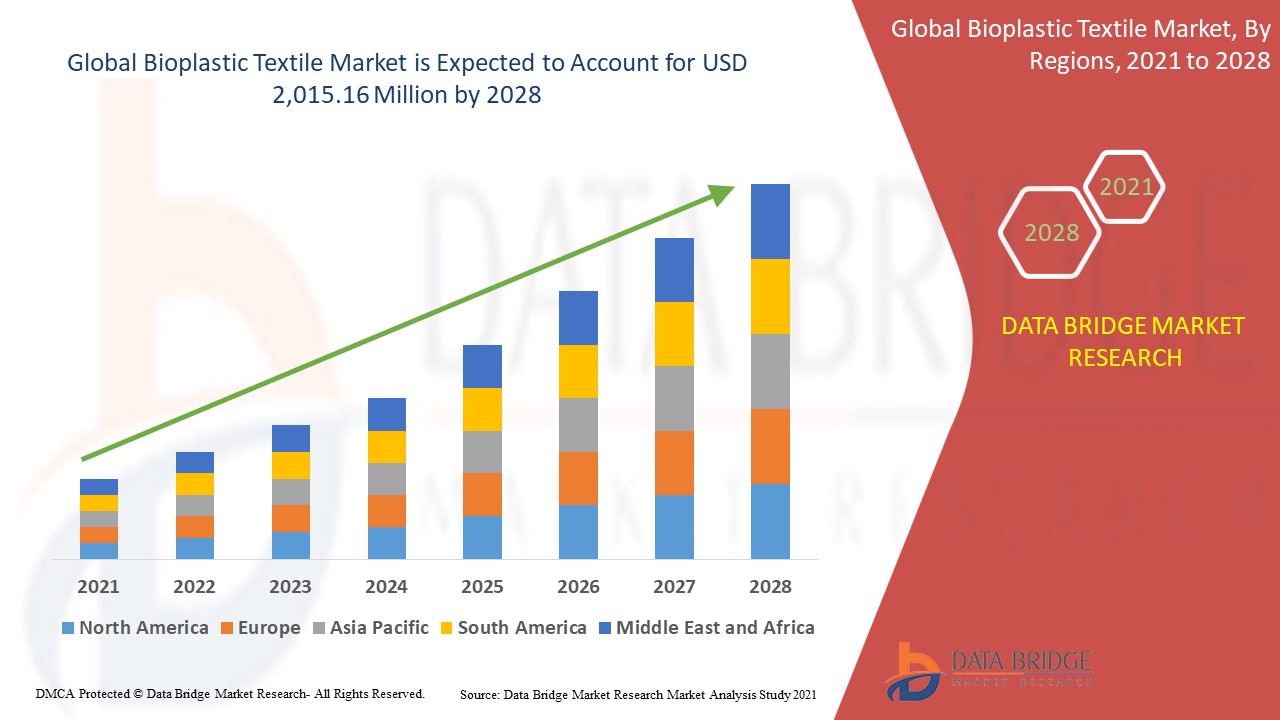Global Bioplastic Textile Market, By Material (Polyamide, Polytrimethylene Terephthalate, Polyethylene Terephthalate, Polylactic Acid, Others), Source (Beet, Sugarcane, Cassava, Corn Starch, Others), Application (Clothing, Footwear, Home Textiles, Others), Country (U.S., Canada, Mexico, Germany, France, U.K., Italy, Spain, Russia, Turkey, Belgium, Netherlands, Switzerland, Luxemburg, Rest of Europe, Japan, China, South Korea, India, Australia And New Zealand, Singapore, Thailand, Malaysia, Indonesia, Philippines, Rest of Asia-Pacific, Brazil, Argentina, Rest of South America UAE, Saudi Arabia, Egypt, Israel, South Africa, And Rest Of Middle East and Africa) Industry Trends and Forecast to 2028.


Market Analysis and Insights: Global Bioplastic Textile Market
Data Bridge Market Research analyses that the bioplastic textile market is expected to grow at a CAGR of 4.2% in the forecast period of 2021-2028 and is likely to reach at USD 2,015.16 million by 2028.
Bioplastic textiles are the type of materials derived from renewable feedstock such as corn starch, sugarcane, woodchips, straw and other biodegradable sources. Bioplastics are a kind of plastic which can be made from natural resources such as vegetable oils and starches.
The rise in awareness regarding the adverse effects of plastics on the environment is the major factor accelerating the growth of the bioplastic textile market. Furthermore, increasing adoption of the bioplastic product in materials and residential textiles, rising government initiatives for the utilization of environment-friendly product and favourable government policies and eco-friendly raw materials are the key driving factor for the market growth. However, the high manufacturing cost of bioplastic textiles and rise in the prices of the raw materials restrains the bioplastic textile market, whereas, the high R&D costs will challenge market growth.
- In addition, the growing demand for bio-based products due to strict regulatory parameters along with green credits provided by the government for boosting sustainable products will create ample opportunities for the bioplastic textile market in the forecast period of 2021 to 2028.
This bioplastic textile market report provides details of new recent developments, trade regulations, import export analysis, production analysis, value chain optimization, market share, impact of domestic and localised market players, analyses opportunities in terms of emerging revenue pockets, changes in market regulations, strategic market growth analysis, market size, category market growths, application niches and dominance, product approvals, product launches, geographical expansions, technological innovations in the market. To gain more info on bioplastic textile market contact Data Bridge Market Research for an Analyst Brief, our team will help you take an informed market decision to achieve market growth.
Global Bioplastic Textile Market Scope and Market Size
The bioplastic textile market is segmented on the basis of material, source, and application. The growth amongst the different segments helps you in attaining the knowledge related to the different growth factors expected to be prevalent throughout the market and formulate different strategies to help identify core application areas and the difference in your target market.
- On the basis of material, the bioplastic textile market is segmented into polyamide, polytrimethylene terephthalate, polyethylene terephthalate, polylactic acid and others.
- On the basis of source, the bioplastic textile market is segmented into beet, sugarcane, cassava, corn starch and others.
- On the basis of application, the bioplastic textile market is segmented into clothing, footwear, home textiles and others.
Bioplastic Textile Market Country Level Analysis
The bioplastic textile market is analysed and market size, volume information is provided by country, material, source, and application as referenced above.
The countries covered in the bioplastic textile market report are U.S., Canada and Mexico in North America, Germany, France, U.K., Netherlands, Switzerland, Belgium, Russia, Italy, Spain, Turkey, Rest of Europe in Europe, China, Japan, India, South Korea, Singapore, Malaysia, Australia, Thailand, Indonesia, Philippines, Rest of Asia-Pacific (APAC) in the Asia-Pacific (APAC), Saudi Arabia, U.A.E, Israel, Egypt, South Africa, Rest of Middle East and Africa (MEA) as a part of Middle East and Africa (MEA), Brazil, Argentina and Rest of South America as part of South America.
Europe dominates the bioplastic textile market and will continue to flourish its dominance during the forecast period due to the development of innovative materials in the region and rising demand for eco-friendly and sustainable products associated with stringent government regulations. However, Asia-Pacific will continue to project the highest CAGR for this period because of the rise in the government initiatives to promote bio-based products and increasing consumer awareness for bioplastics.
The country section of the bioplastic textile market report also provides individual market impacting factors and changes in regulation in the market domestically that impacts the current and future trends of the market. Data points such as consumption volumes, production sites and volumes, import export analysis, price trend analysis, cost of raw materials, down-stream and upstream value chain analysis are some of the major pointers used to forecast the market scenario for individual countries. Also, presence and availability of global brands and their challenges faced due to large or scarce competition from local and domestic brands, impact of domestic tariffs and trade routes are considered while providing forecast analysis of the country data.
Competitive Landscape and Bioplastic Textile Market Share Analysis
The bioplastic textile market competitive landscape provides details by competitor. Details included are company overview, company financials, revenue generated, market potential, investment in research and development, new market initiatives, global presence, production sites and facilities, production capacities, company strengths and weaknesses, product launch, product width and breadth, application dominance. The above data points provided are only related to the companies’ focus related to bioplastic textile market.
The major players operating in the bioplastic textile market report are DSM, Medtronic, Integra LifeSciences Corporation, Freudenberg Group, Bally Ribbon Mills, ATEX TECHNOLOGIES, Confluent Medical Technologies, Elkem Silicones, BioSpace, KCWW., Mölnlycke Health Care AB, Rochal Industries LLC, AstraZeneca, 3M, Munksjö, Meister & Cie AG, Biomedical Structures LLC, among others.
SKU-

